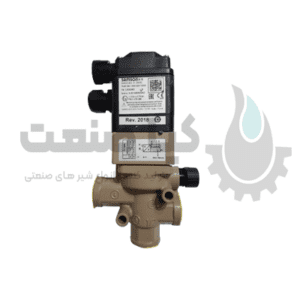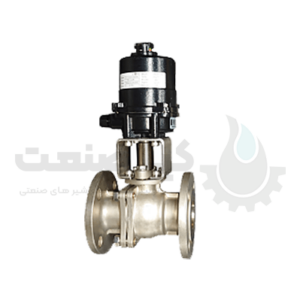electric valve
Showing all 2 results
What is an electric valve or solenoid valve and its types
A solenoid is a coil that creates a magnetic field only if it is covered by a core or any magnetic object.
The solenoid controls the solenoid valve and this valve is used as a switch to control the flow of water or air.
The opening of the valve will happen if the solenoid is active and if the electron is inactive, the valve will stay close.
These valves are electromechanical types and are used to control the flow of gas and liquid.
Solenoid valves are used in many applications and are usually used in refrigeration and air conditioning systems, their operation is very simple to turn the refrigerant flow on and off.
These valves can be considered as electro-pneumatic relays.
Pneumatic output is based on electrical input
These solenoid valves are the interface between electronic control system and pneumatic power.
Electric current is used to control the solenoid valve.
They are called a two-position device because they are either all the way on or all the way off.
The operation of these valves can be done in AC or DC voltage.
Solenoid valve components
This solenoid valve consists of a body, a magnetic core connected to the stem and disk, and an electronic coil. A spring is used to release and close the valve.
Solenoid Valve: It is an electric coil and has a piston or core in its center and the core is coaxial with the solenoid. This is a coil of copper wire
Core: The core is called a piston and it is a magnetic component that moves when the solenoid is energized.
Valve Body: The body of the valve is selected so that it should be compatible with the liquid, it is mainly composed of brass, stainless steel and aluminum.
Stem: is used to release and close the valve spring
Bonnet: A threaded nut or square flange that secures the assembly of the magnetic operator to the valve body.
Seat seals: It is usually installed on the MP, it is used to close the valve hole.
Why do we need solenoid valves?
If we need to control the liquid flow automatically, we should use a solenoid valve.
Solenoid valves are widely used in many chemical processing industries.
Solenoid valves are devices that can convert electrical power into mechanical force and motion.
They are also used in many hydraulic circuits as direct control valves and are used to change the direction of flow in a hydraulic system.
Solenoid valves are mostly used for silent operation that requires a very high speed of response, solenoid valves are able to open or close in 8-12 milliseconds.
solenoid What is a solenoid?
Electronoid is an electric coil and in its center there will be a moving electromagnetic core.
This core is known as a piston in the rest position. The piston closes a small hole.
If we pass an electric current through the coil, a magnetic field is created and a force is exerted on the piston by the magnetic field.
Because of this, the piston is pulled towards the center of the coil and the hole is opened.
This principle is used in electric valves.
This device is capable of linear movement and can also be considered as an actuator.
Liner force will be generated by the solenoid if it is energized.
How are solenoid valves made?
The coil of the solenoid valve is made of copper wire.
An insulating layer is used to separate the layers of wire, and varnish is applied to the coil so that it is not affected by solvents or other moisture.
Multi-layered sheets are used to make the electronic frame and when current passes through it, it becomes magnetized.
The electric piston is not a stator device and it is behind the moving mechanism of the solenoid piston made of laminated steel.
In a solenoid valve there is a coating – it can be on the solenoid or the entire valve.
How does a solenoid valve work?
Electric current passes through the electron coil and creates a magnetic field.
This field brings the piston closer to the center of the coil and opens this hole.
In this way, electronic valves convert electrical energy into mechanical energy, and this mechanical energy is used to open or close the valve.
Metal or rubber seals are used and can also have an electrical interface for easy control.
A spring is also used in a solenoid valve to hold the valve in the open or closed position while the valve is in the closed position.
Constant flow is required for the valve to remain open. If there is no current, the valve will return to its original position.
Types of solenoid valves
Pilot operated valve
In this type of valve, a pilot control is used, so the size of the electronoid can be kept to a minimum, thus reducing power consumption and heat generation.
In pilot solenoid valves, the electrical signal is converted into an electron, which activates the pilot valve
Pilot operated valves can be piston or diaphragm type and require differential pressure to keep the valve closed. These valves have fast response time and are relatively cheap.
Direct-acting solenoid valve
In a direct solenoid valve, a piston opens and closes the valve. These valves have low flow and high differential pressure dropare. The direct-acting type has a faster response than a pilot-operated valve solenoid.
Two-way solenoid valves
In both directions, electronic valves have an inlet and an outlet pipe connection.
Three-way solenoid valves
In this type of electronic valve, it has three pipe connections and two holes, so if one is open, the other is closed.
These valves have three operating modes, the first is normally closed construction in this type the pressure port is closed and the exhaust port is connected to the cylinder port with the energy valve.
The pressure port is connected to the cylinder port and the exhaust port is closed.
Four-way electric valves
These valves are mainly used to work with two-way cylinders. This solenoid valve has four or five pipe connections of one pressure, two cylinders and one or two exhausts.
In one valve position, the pressure is connected to one port and the other is connected to the exhaust. In the other valve position, the pressure and exhaust in the cylinder connection are reversed.
Important factors in choosing a solenoid valve
The type of valve should be determined as two, three or four way
Voltage and pressure
The materials used to make the solenoid valve are used like brass, plastic…
Coil and connection type
Type of electrical enclosure
Maximum and minimum operating pressure difference
aperture diameter
Allowable internal leakage
Advantages of using electric valves
Solenoid valves can perform fast operation, these valves can open and close very quickly
Solenoid valves have high reliability
Automatic liquid flow control
They have a useful life
These valves have a compact design and limited pressure drop
Application of solenoid valve
Solenoid valves are widely used in many industrial applications.
They are used in fields that require compressed and liquid air.
These valves are made for remote control, that’s why they are used in automatic irrigation control system.
Solenoid valves are used in many chemical industries, construction works and air conditioning facilities.
سلونوئید ولو DC بهتر است یا AC؟
Buy electric valve
You can find all kinds of solenoid valves from کیاصنعت تهیه کنید.
Electric valve price
Electric valves have different prices according to the material they are made of and their brand and size. Contact us to know the price.


